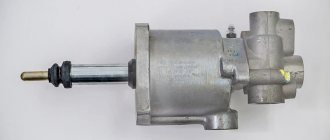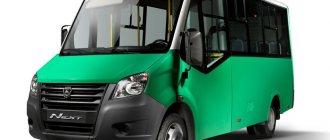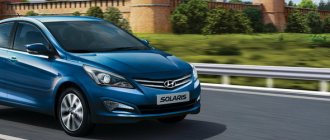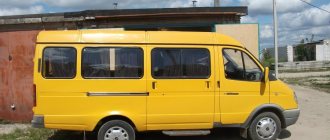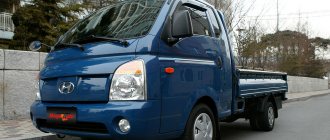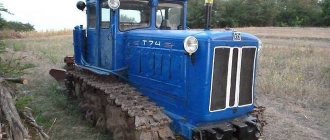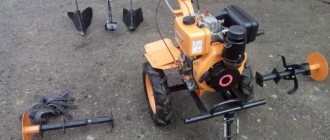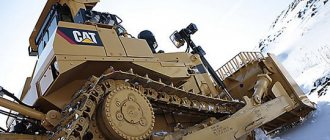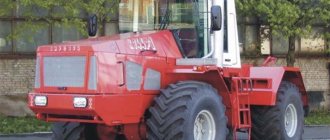Nissan Atlas
(Japanese: 日産・アトラス) is a Japanese light commercial vehicle manufactured by Nissan.
The truck is being built by UD Trucks for the Japanese market, and by the Renault-Nissan alliance for the European market. Atlas trucks (1 to 1.5 tons)
replaced the lightweight Nissan Cabstar and Prince Homer, while
medium-duty trucks (2 to 4 tons)
replaced the heavy Nissan Caball and Nissan Clipper. The first car with the Atlas nameplate appeared in December 1981. The name goes back to Greek mythology, where the Titan Atlas held the Earth on his shoulders.
Atlas also known as Nissan Cabstar
,
Renault Maxity
,
Samsung SV110
and
Ashok Leyland Partner
, depending on location. The truck is sold all over the world.
Light duty trucks (1-1.5 tons) [edit | edit code]
F22 (Atlas 100/150, 1982—1992) [edit | edit code]
In February 1982, the F22 Atlas 100/150
. [1] The car was equipped with Z20 and Z16 gasoline engines, as well as SD25 and SD23 diesel engines. After the appearance of vans and multi-stops, they began to be produced in the line. The body parts remain largely the same as on the Cabstar/Homer. In May 1985, production of the Atlas began in India. In November 1986, the front grille was changed and the SD23 and SD25 diesel engines were replaced by the TD23 and TD27. In 1986, a multi-stop truck appeared. Since 1988, the color of the front grille has changed from white to black. In June 1990, gasoline engines were changed: instead of Z16 and Z20, NA16 and NA20 began to be installed.
In Europe, the Atlas F22 was sold as the Nissan Cabstar, and became a popular truck in the UK market due to its reliability and payload capacity. The Cabstar F22 was available in the UK market with the 1,952 cc Z20S petrol engine. The Cabstar E also became available in 1990. [2] In Taiwan, the F22 continued to be sold as the Yue Loong Homer. Among minibuses, the Atlas competed with the Bedford CF and Ford Transit. With the truck's increasing popularity in the African market, the vast majority of early F22 models from the UK were exported to Africa.
Second generation, F23 (Atlas 10, 1992—2007) [edit | edit code]
The F23 model appeared in January 1992. The cars were equipped with NA16S and NA20 gasoline engines and TD23 and TD27 diesel engines. In 1995, the front grille design was changed. In June 1995, the TD23 engine was replaced by the TD25. Since August 1995, the NA16S gasoline engine was no longer installed, and in August 1997, the new QD32 diesel engine began to be installed. Since June 1, 1999, there has been a minor restyling. The shape of the front grille and bumper have changed, and the interior and exterior design have changed. The purpose of the changes was the possibility of installing a DOHC KA20DE four-cylinder gasoline engine (instead of the OHC NA20S). In addition, vehicles with a carrying capacity of 1.25 and 1.3 tons appeared. On October 23, 2000, Autech developed cars running on liquefied gas. The KA20 engine has undergone modifications. On August 21, 2002, electric windows, a tachometer, and an indicator of its position on cars with an automatic transmission appeared. On August 23, 2004, the QD32 engine was modified.
The capacity of the truck is 3 or 6 people, depending on the cab (two- or four-door). Transmission 4-speed Automatic or 5 speed Manual transmission. Drive system - rear or all-wheel drive. Dimensions: length 4460/4690 mm, width 1695 mm, height 1930/1980 mm, wheelbase 2515/2335 mm. The following engines were installed on the F23:
- 2.3-liter inline-4 TD23
- 2.5-liter inline-4 TD25
- 2.7 L inline 4 cylinder TD27
- 3.2-liter inline-4 QD32
- 1.6-liter inline-4 NA16S
- 2 liter inline 4 cylinder NA20
- 2 liter inline 4 cylinder KA20DE
In the US, the UD 1400 truck was similar to the Atlas F23, but it was equipped with a 4.7-liter turbodiesel engine producing 175 hp. [3] Its production ceased in 2010.
In South Africa, the Atlas F23 was sold as the UD 35 and UD 40, and was powered by a 4.2-litre 6-cylinder turbodiesel engine producing 87kW. [4]
1992-1995, rear view
Third generation, F24 (since 2007) [edit | edit code]
On September 20, 2006, the F24 was first introduced in Europe as the Cabstar. With the advent of the new one, a new LDT platform was developed. In addition, at this time, European and Japanese standards differed regarding bumper sizes. The vehicle's carrying capacity ranged from 1.15 to 2 tons [5], and 2.5 gasoline and 3-liter turbodiesel engines began to be installed on it.
On June 14, 2007, production of the F24 began in Japan. [6] The truck was equipped with a ZD30DDTi diesel engine and a QR20DE gasoline engine. The type of gearbox and maximum load capacity depended on the type of engine. So, 5 tbsp were available. automatic, 5 speed and 6-st. Mechanics. The maximum carrying capacity of the vehicles was 1.5 tons, 1.75 tons and 2 tons. At the same time, cars with a carrying capacity of 1.75-2 tons were equipped with 6-speed. boxes.
On July 30, 2009, the engine would be modified, its output characteristics and gear ratios would be changed, and fuel consumption would be reduced. On November 12, 2009, production of the NT400 Cabstar
. [7] On March 1, 2010, the following improvements occurred: the shape of the turn signal repeater was changed to comply with the changed lighting regulations, and a keyed glove box was added as an option. On August 30, 2010, on vehicles with a carrying capacity of 1.5 tons, in accordance with 2015 standards, the efficiency of fuel combustion in a diesel engine was increased (on sale from September 15). New colors and body designs also appeared. On October 27, 2011, an exhibition of the e-NT400 electric car was held in Tokyo.
Since January 2011, F24 production has been transformed into Nissan Shatai. [8] In 2011-2012, changes were made to engines aimed at meeting standards. The compression ratio of the diesel engine has been reduced, the fuel injection and exhaust systems have been changed. Fuel consumption has been reduced and the transmission gear ratio has been changed. A car with a carrying capacity of 1.85 tons appeared.
In 2013, the driver's position was changed; cameras were installed on the vehicle, located in 4 places, reflecting the truck's surroundings. Refrigerated trucks have also received a significant improvement. On April 1, 2020, fuel consumption on diesel cars was reduced by changing the tire size. As a result, 1.5T diesel four-wheel drive vehicles have achieved new fuel economy standards for 2020. [9]
In India, the F24 is known as the Ashok Leyland Partner (civilian truck) and Ashok Leyland Garuda (military truck).
In Europe, starting in 2007, the Atlas F24 was sold as the Nissan Cabstar, replacing the F23. Built at the Spanish factories of the Renault-Nissan alliance, the Renault Maxity, similar to the Atlas, used Nissan YD25DDTi 2.5-liter turbodiesel engines with a power of 110-130 hp. and Nissan ZD30DDTi 3-liter turbodiesel producing 150 hp.
The capacity of the truck is 3 or 6 people, depending on the cab (two- or four-door). The F24 was powered by two inline 4-cylinder engines: a 2-litre QR20DE and a 3-litre ZD30DDTi. Transmission 5-speed and 6-st. Automatic transmission, 5 speed and 6-st. Manual transmission. Drive system - front-wheel or all-wheel drive. Dimensions: length 4455/5990 mm, width 1695/1885 mm, height 1990/2175 mm, wheelbase 2270/3355 mm. Vehicle weight is 1600–2300 kg.
At the end of 1981, the Japanese automobile corporation Nissan launched the production of the N40 platform, which was heavier than the passenger cars it produced.
As a result, in February 1982, a light truck with serial number F22 was launched into mass production, which was named Nissan Atlas.
NISSAN ATLAS for sale, prices and photos
ARAI Oyama
lot 3992
2019-06-29
- Body UG4YH41
- Year 1993
- Volume 4210
- Gearbox F5
- Mileage 173 000
- Grade 3
ARAI Oyama
lot 3510
2019-06-29
- Body SP8F23
- Year 1996
- Volume 2660
- Gearbox F5
- Mileage 66 000
- Grade 3
- Body AKR82AN
- Year 2006
- Volume 4570
- Gearbox F5
- Mileage 107 000
- Grade ***
ARAI Oyama
lot 8794
2019-06-29
ARAI Oyama
lot 3361
2019-06-29
TAA Yokohama
lot 63534
2019-06-29
- Body SH2F23
- Year 2004
- Volume 2000
- Gearbox F5
- Mileage 12 000
- Grade 3.5
ARAI Oyama
lot 2581
2019-06-29
ARAI Oyama
lot 3281
2019-06-29
- Body AKR69EA
- Year 1999
- Volume 3100
- Gearbox F5
- Mileage 41 000
- Grade 3.5
ARAI Oyama
lot 3854
2019-06-29
ARAI Oyama
lot 3892
2019-06-29
- Body AKS71GR
- Year 2001
- Volume 4570
- Gearbox F5
- Mileage 16 000
- Grade 3
ARAI Oyama
lot 3387
2019-06-29
ARAI Oyama
lot 3385
2019-06-29
- Body SR8F23
- Year 2001
- Volume 3150
- Gearbox F5
- Mileage 152 000
- Grade 2
ARAI Oyama
lot 1046
2019-06-29
ARAI Oyama
lot 1047
2019-06-29
- Body SQ1F24
- Year 2011
- Volume 1990
- FAT gearbox
- Mileage 71 000
- Grade 3
ARAI Oyama
lot 3276
2019-06-29
ARAI Oyama
lot 3972
2019-06-29
- Body AKR66ED
- Year 1998
- Volume 4330
- Gearbox F5
- Mileage 268 000
- Grade 3
ARAI Oyama
lot 2588
2019-06-29
ARAI Oyama
lot 4028
2019-06-29
- Body SP6F23
- Year 2003
- Volume 2700
- Gearbox F5
- Mileage 80 000
- Grade 3.5
ARAI Oyama
lot 3518
2019-06-29
ARAI Oyama
lot 4096
2019-06-29
- Body AKR66LR
- Year 1999
- Volume 4330
- Gearbox F5
- Mileage 189 000
- Grade 3
ARAI Oyama
lot 8807
2019-06-29
Gearbox ..S
Mileage 87 000
Grade ***
ARAI Oyama
lot 3329
2019-06-29
- Body SH2F23
- Year 2003
- Volume 1990
- Gearbox F5
- Mileage 159 000
- Grade 3.5
ARAI Oyama
lot 3576
2019-06-29
ARAI Oyama
lot 2555
2019-06-29
- Body SQ1F24
- Year 2008
- Volume 1990
- FAT gearbox
- Mileage 166 000
- Grade 4
ARAI Oyama
lot 4063
2019-06-29
ARAI Oyama
lot 3149
2019-06-29
- Body APR71LR
- Year 1996
- Volume 4570
- Gearbox F5
- Mileage 200 000
- R rating
ARAI Oyama
lot 3148
2019-06-29
Tractor MTZ 920 Belarus
ARAI Oyama
lot 3756
2019-06-29
- Body APR81LV
- Year 2003
- Volume 4770
- Gearbox F6
- Mileage 2000 000
- Grade 3
ARAI Oyama
lot 3755
2019-06-29
ARAI Oyama
lot 3500
2019-06-29
- Body APR66LR
- Year 1997
- Volume 4570
- Gearbox F6
- Mileage 505 000
- R rating
ARAI Oyama
lot 3738
2019-06-29
ARAI Oyama
lot 3589
2019-06-29
- Body WF22
- Year 1991
- Volume 2000
- Gearbox F5
- Mileage 73 000
- R rating
ARAI Oyama
lot 3663
2019-06-29
ARAI Oyama
lot 3412
2019-06-29
- Body APR81AN
- Year 2006
- Volume 4770
Gearbox ..S
Mileage 341 000
R rating
ARAI Oyama
lot 3375
2019-06-29
ARAI Oyama
lot 3312
2019-06-29
- Body AKR81A
- Year 2006
- Volume 4800
Gearbox ..S
Mileage 137 000
Grade 3
ARAI Oyama
lot 3770
2019-06-29
ARAI Oyama
lot 3926
2019-06-29
- Body AGF22
- Year 1988
- Volume 2660
- Gearbox C5
- Mileage 191 000
- R rating
ARAI Oyama
lot 3398
2019-06-29
ARAI Oyama
lot 3903
2019-06-29
- Body AKR81AD
- Year 2005
- Volume 4770
Gearbox ..S
Mileage 141 000
Grade 3
ARAI Oyama
lot 3657
2019-06-29
JU Gifu
lot 2163
2019-06-29
- Body SZ2F24
- Year 2007
- Volume 3000
- Gearbox F5
- Mileage 99 000
- Grade 3
JU Gifu
lot 70011
2019-06-29
TAA Yokohama
lot 63542
2019-06-29
- Body SQ2F24
- Year 2015
- Volume 2000
- Gearbox F5
- Mileage 44 000
- Grade 3.5
TAA Yokohama
lot 63505
2019-06-29
Isuzu Kobe
lot 1039
2019-06-28
- Body TZ3F24
- Year 2009
- Volume 3000
- checkpoint
- Mileage 284 000
- Grade 3.5
Isuzu Kobe
lot 1200
2019-06-28
ZERO Chiba
lot 143
2019-06-28
- Body TZ2F24
- Year 2013
- Volume 3000
- Gearbox 6F
- Mileage 59 000
- Grade 3.5
ZERO Chiba
lot 142
2019-06-28
LAA Okayama
lot 9013
2019-06-28
FULL-JUST-LOW W CAB
- Body AKR71EA
- Year 2000
- Volume 4600
- FAT gearbox
- Mileage 59 000
- Grade 3
JU Miyagi
lot 9009
2019-06-28
4WD FULL-JUST-LOW W CAB
Review of cars produced before 2005
Under the Atlas brand, this light truck is produced only for domestic, Japanese consumption. As it penetrated the urban freight transportation market, many modifications were created with different bodies, cabs, superstructures and engines.
Nevertheless, the main concept of this car, which was laid down by its creators, was preserved in all trim levels:
- The Nissan Atlas chassis
The spar size is 128x52x4 mm. The engine, cab, body, suspension and axles are attached to the frame. The cabin , whatever it may be - single or double, is located above the engine.
This provides good visibility of the road ahead and a small turning radius of 5 meters.
Traditionally for Japanese cars of this class, the windshield is large, but this does not reduce the strength of the cabin. The side windows retained their original shape for a long time, allowing the driver to control the road situation literally under the front wheel.
The main
bodies for the first ten years were flatbeds and vans.
Base machine parameters
Main technical characteristics of the base Nissan Atlas car:
Geometric dimensions of the car
Nissan Atlas cars were most often equipped with automatic transmissions (four- or five-speed).
The rear suspension has always been designed as a dependent suspension on springs with shock absorbers. The front suspension was mounted in different versions. It could be either independent, but with a transverse spring, or dependent, with a set of springs on both sides.
As a rule, cars with all-wheel drive, that is, with two drive axles, were made in this version.
On the first models, the brakes were installed according to the following scheme. The front is disc, the rear is drum. The brake system is dual-circuit with a vacuum booster. Steering is rack and pinion type, with built-in hydraulic booster in the base model.
The designers were concerned about safety when using this machine. Three-point seat belts and airbags are standard. The front and rear bumpers are equipped with shockproof devices.
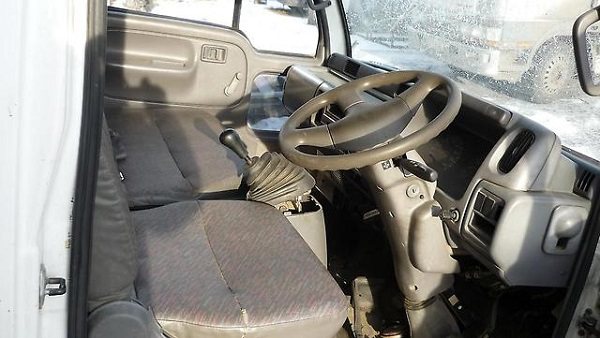
The steering wheel in the cabin is installed on the right side, and the entire set of instruments is located according to this.
The driver's seat is designed in such a way that a person experiences minimal stress during the working day. Good lateral support and a maximum of various adjustments contribute to this.
Convenience is added by the steering column, which can be adjusted both for reach and tilt.
The cabin is provided with good air ventilation not only thanks to the lowerable side windows, but also due to the hatch installed in the cabin roof.
After reading this article, you will know the price of the MAZ-6312.
The improvement of the Atlas model can be traced using the example of cars produced by the Nissan concern for the period from 1990 to 2005:
- Dimensions for standard length: 4,690x1,690x1,990 mm.
- The dimensions of the machine with an average platform length are 5,990x2,000x2,115 mm.
- The geometric dimensions of the machine with a long wheelbase are 6,735x2,020x2,270 mm.
Different cab options were installed on the chassis, and this concerned not only the division into single and double.
Cabins for three people also had different sizes, both in width and height. This was done in order to increase the comfort of the driver and passengers in the cabin.
The configurations of the Atlases changed significantly. If in 1990 these were trucks and vans, then a year later a dump truck and a garbage truck were added to the list of vehicles of this brand.
Two years later, a truck appeared with a tailgate in the form of an elevator on hydraulic lifts to facilitate loading goods into the body.
In 2000, the Nissan Atlas branded car with a manipulator in the body was produced. It became possible to independently load heavy cargo into the car and transport up to 1,500 kg.
Over the course of fifteen years, twelve different engines of varying power from 75 to 155 hp were installed on Atlases in different configurations. With. Among them were both gasoline and diesel internal combustion engines. At the same time, automatics and mechanics were used as transmissions.
"Nissan Atlas" of this period in the "flatbed truck" or "van" design can be purchased at prices ranging from 200 to 750 thousand rubles.
Model history and purpose
Two years later, a truck appeared with a tailgate in the form of an elevator on hydraulic lifts to facilitate loading goods into the body. The Nissan Atlas is ideal for constant and intense work. The car chassis is a rigid frame made of channel-type spars size: These elements are fastened with strong steel cross members. The frame is the basis of the structure; axles, body, cabin, engine and suspension are attached to it. The cabin, regardless of the type of design, is installed above the unit, which provides good visibility of the road ahead and a small turning radius of no more than mm.
The Nissan Atlas is equipped with a cabin with a large windshield, which is typical for Japanese cars. This does not affect the strength of the structure. Enlarged side windows of an original shape allow the driver to control the situation within a large radius.
The front suspension on Nissan Atlas cars was installed in different versions.
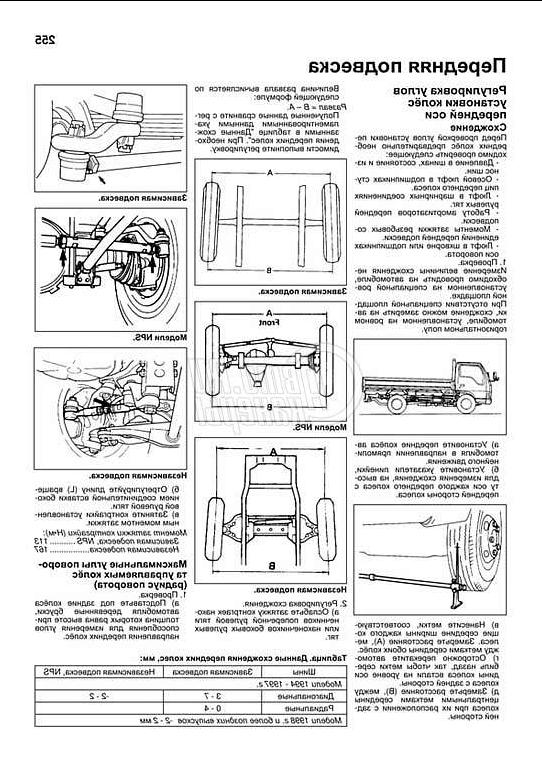
The client was offered a dependent suspension with a set of springs on both sides and an independent suspension with a transverse spring. The rear suspension has always been the same type - a dependent version on springs with shock absorbers.
Dimensional and weight characteristics
In the basic version, the Nissan Atlas was front-wheel drive, with all-wheel drive available as an option. The second generation of the car had a classic braking system with front disc brakes and rear drum brakes. On the newer generation, disc brakes were also installed at the rear.
The brake system itself was dual-circuit with a vacuum booster. Nissan Atlas received rack and pinion steering. Already in the basic version, the model acquired a built-in power steering, making driving easier.
The cabin of the Nissan Atlas is quite functional, but ascetic. At the same time, everything you need is available inside. The steering column is comfortable and adjustable in several directions for tilt and reach. On most versions used in Russia, the steering wheel is located on the right, which is not very convenient. The driver's seat has many adjustments and excellent lateral support.
The passenger seats are highly comfortable. The dashboard displays a minimum number of indicators.
However, they are all installed very competently, so the driver does not have to tilt his head to see. The car has a special alarm system. When reversing, a special signal is given.
The driver will hear a similar sound if he does not close one of the cab doors. Japanese designers paid great attention to safety.
At the end of 1981, the Japanese automobile corporation Nissan launched the production of the N40 platform, which was heavier than the passenger cars it produced.
As a result, in February 1982, a light truck with serial number F22 was launched into mass production, which was named Nissan Atlas.
Engine and its parameters
Since 2007, cars of this model of the F24 factory series have been produced with QR20DE and QR25DE engines. These are four-cylinder power units with an in-line arrangement of cylinders, the working fuel for which is gasoline.
These engines are produced at .
QR20DE engine characteristics:
| Nissan Atlas | |
| Total information | |
| Manufacturer | Nissan |
| Years of production | 1982–present |
| Assembly | Nissan Shatai, UD Trucks |
| Class | Freight car |
| Other designations | Nissan Cabstar (Europe, Australia and China) Renault Maxity (Europe) Samsung SV110 (Asia) UD Condor (Japan) Yue Loong Homer (Taiwan) Tan Chong Pahlawan (Malaysia) UD 1200/1300/1400 (USA and Canada) Dong Feng Captain N300 (PRC) Ashok Leyland Partner (India) Ashok Leyland Garuda (India, military truck) |
| Transmission | |
| Nissan (manual) Aisin (automatic) | |
| 4 430x1 690x1 935 mm | |
| Wheelbase | |
| Track - front/rear | 4×4 |
| Clearance | |
| Number of seats in the cabin | |
| GVWR | |
| Load capacity | |
| Engine | |
| Developed power | |
Series 100 and 150
On the Internet, in one of the reviews about the Atlas 100 model, there is interesting information about how a car enthusiast purchased two flatbed trucks produced in 1983 at a price of 90 thousand rubles for both cars and assembled a workhorse for himself, which he still uses , and he has the best reviews about it in terms of all technical characteristics.
If the driver took good care of such a car, carried out timely preventive maintenance, changed oil, filters and consumables, then even when driving on our roads the car retained its positive qualities and served its owner faithfully.
Series 200
In 1993, the Nissan Atlas 200 Gate Lift model with an H41 body appeared on the list of Atlas modifications. This machine was equipped with an FD42 engine with a power of 125 hp. With.
In the same year, the Atlas 200 N41 was released with an aluminum van, with a wing-type van opening upward and with a loader crane.
The same modifications of the Nissan Atlas 200 H41 were produced in 1994-1996.
Since 2000, the numbers 10 and 20 have appeared in the Atlas names. With F-series bodies, these modifications were written as “Nissan Atlas 10 F23”.
In the period from 2007 to 2012, cars were produced under the Atlas brand with bodies of the N43 series. During this time, modifications such as a tanker truck, a sewer truck, a garbage collector, a dump truck, an on-board truck with a crane, and a fire truck were produced.
From 2007 to the present, Nissan Atlas F24 series cars have rolled off the assembly line in Japan:
- with onboard platform;
- with flatbed and double cabin;
- onboard with crane;
- side with ramp;
- refrigerated truck;
- dump truck with three-way unloading.
And here you can find out interesting design features of the BAW Tonik car.
Modifications
The Nissan Atlas light truck was produced in its basic version until 1993, then the 200 Gate Lift modification was created, which was equipped with a 125 hp FD42 engine. pp., reliable and economical. And on the basis of this model, an onboard platform with a loader crane was created.
In the period from 2007 to 2012, the Nissan Atlas was produced with a body of the N43 series, on which tanks, lifting devices, waste containers, fire fighting equipment, and sewage systems were installed. However, most of the vehicles were produced with a dump body, which were indispensable on construction sites. These vehicles mainly transported sand, cement, crushed stone and gravel. But the dump body of a sealed design made it possible to transport mortar or concrete over short distances.
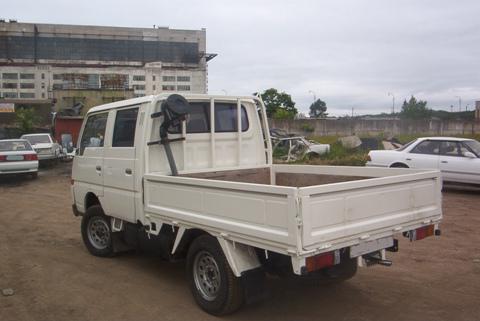
A total of six modifications were created:
- dump truck with unloading on three sides;
- onboard platform with lift;
- refrigerated truck;
- onboard platform with ramp;
- platform with three folding sides;
- a shortened platform with a double cabin is a convenient modification for moving a crew along with cargo.
Cars on the Russian car market
Nissan Atlas has been produced only for the domestic Japanese market for thirty-three years. Nevertheless, in Russia, especially in the Far East and Siberia, the Nissan Atlas is very popular.
After the opportunity arose, businessmen began to import this car to Russia in large quantities. These were mainly flatbed vehicles and vans, but with the beginning of the 2000s, onboard trucks with manipulators, dump trucks and tow trucks became popular.
The price of Nissan Atlas cars for cars younger than 2007, depending on the year of manufacture and configuration, ranges from 700 thousand to 1 million 300 thousand rubles.
The following video provides an overview of the Nissan Atlas 200 with comments from its owner:
If you find an error, please select a piece of text and press Ctrl+Enter.
The Nissan Atlas is a Japanese-made light truck, which has been in production since the end of 1981. For many years it was produced primarily for the domestic market, enjoying great demand in Japan. The European market learned about it thanks to the Renault-Nissan alliance. In addition, Atlas is very popular today in Australia, South Africa, and India, where it is regularly transported (and is also produced in India). The first models began to arrive in Russia in the late 90s (mainly vans and on-board vehicles) thanks to private merchants. Most often, Nissan Atlas can be seen on the roads of the Far East and Siberia. In addition to standard flatbed and van modifications, all over the world Nissan Atlas trucks operate as dump trucks, tow trucks, and have also proven themselves as fire engines.
Safety
The cabin was equipped with two frontal emergency airbags, three-point belts with pretensioners, and both bumpers were impact-resistant, significantly reducing the force of impact in a collision.
Since the Nissan Atlas truck was designed for low speeds, it was not equipped with a directional stability system, but it was required to be equipped with ABS anti-lock brakes.
The Nissan Atlas is a Japanese-made light truck, which has been in production since the end of 1981. For many years it was produced primarily for the domestic market, enjoying great demand in Japan. The European market learned about it thanks to the Renault-Nissan alliance. In addition, Atlas is very popular today in Australia, South Africa, and India, where it is regularly transported (and is also produced in India). The first models began to arrive in Russia in the late 90s (mainly vans and on-board vehicles) thanks to private merchants. Most often, Nissan Atlas can be seen on the roads of the Far East and Siberia. In addition to standard flatbed and van modifications, all over the world Nissan Atlas trucks operate as dump trucks, tow trucks, and have also proven themselves as fire engines.
Main technical characteristics of the base Nissan Atlas car:
Nissan Atlas cars were most often equipped with automatic transmissions (four- or five-speed).
The rear suspension has always been designed as a dependent suspension on springs with shock absorbers. The front suspension was mounted in different versions. It could be either independent, but with a transverse spring, or dependent, with a set of springs on both sides.
As a rule, cars with all-wheel drive, that is, with two drive axles, were made in this version.
On the first models, the brakes were installed according to the following scheme. The front is disc, the rear is drum. The brake system is dual-circuit with a vacuum booster. Steering is rack and pinion type, with built-in hydraulic booster in the base model.
The designers were concerned about safety when using this machine. Three-point seat belts and airbags are standard. The front and rear bumpers are equipped with shockproof devices.
The steering wheel in the cabin is installed on the right side, and the entire set of instruments is located according to this.
The driver's seat is designed in such a way that a person experiences minimal stress during the working day. Good lateral support and a maximum of various adjustments contribute to this.
Convenience is added by the steering column, which can be adjusted both for reach and tilt.
The cabin is provided with good air ventilation not only thanks to the lowerable side windows, but also due to the hatch installed in the cabin roof.
The improvement of the Atlas model can be traced using the example of cars produced by the Nissan concern for the period from 1990 to 2005:
- Dimensions for standard length: 4,690x1,690x1,990 mm.
- The dimensions of the machine with an average platform length are 5,990x2,000x2,115 mm.
- The geometric dimensions of the machine with a long wheelbase are 6,735x2,020x2,270 mm.
Different cab options were installed on the chassis, and this concerned not only the division into single and double.
Cabins for three people also had different sizes, both in width and height. This was done in order to increase the comfort of the driver and passengers in the cabin.
The configurations of the Atlases changed significantly. If in 1990 these were trucks and vans, then a year later a dump truck and a garbage truck were added to the list of vehicles of this brand.
Two years later, a truck appeared with a tailgate in the form of an elevator on hydraulic lifts to facilitate loading goods into the body.
In 2000, the Nissan Atlas branded car with a manipulator in the body was produced. It became possible to independently load heavy cargo into the car and transport up to 1,500 kg.
Over the course of fifteen years, twelve different engines of varying power from 75 to 155 hp were installed on Atlases in different configurations. With. Among them were both gasoline and diesel internal combustion engines. At the same time, automatics and mechanics were used as transmissions.
"Nissan Atlas" of this period in the "flatbed truck" or "van" design can be purchased at prices ranging from 200 to 750 thousand rubles.
Specifications
Main technical characteristics of the base Nissan Atlas car:
| Manufacturer |
| Year of issue |
| Material for making the cylinder block |
| Engine cylinder capacity |
| Working cylinder diameter |
| Cylinder piston stroke |
| Number of valves per cylinder |
| Compression ratio of the working mixture in the cylinder |
| Developed power of internal combustion engine |
| Maximum torque |
| Environmental standard |
| Engine life actually installed during operation |
| Engine operating temperature |
| Type of oil poured into the internal combustion engine |
| The amount of oil poured into the power unit |
| Oil change intervals |
| Fuel consumption per 100 km |
Technical characteristics of Nissan Atlas 150
The basic technical characteristics of the Nissan Atlas 150 are as follows:
- from the first release, the steering wheel was equipped with a hydraulic booster, the steering wheel was on the right;
- classic braking system - two circuits with vacuum assistance;
- Manual transmission 4 or 5 speed;
- “engine” 4-cylinder diesel (3 liters) or gasoline (2 liters);
- suspension: front and rear (spring with shock absorbers) dependent;
- the basis of the structure is the frame;
- fuel consumption (per 100 km) – 11.8 liters in the city, 6.7 liters – outside the city;
- there are 2- and 4-door modifications (for 2 and 4 people);
- load capacity – up to 1.3 tons.
The Nissan Atlas 150 does not have high cross-country ability, since the ground clearance is only 18 cm. What sets the car apart is not so much the design features as the reliability of the assembly and the quality of the components.
Double Cabin Atlas
The Nissan Atlas is a Japanese-made light truck classified as a commercial vehicle. The latest generation of the model has been officially sold since 2007. In the European and Russian markets, the truck was also offered under the names Renault Maxity and Nissan NT400 Cabstar.
The model is quite popular in the West. It is often used as a base for a comfortable “home on wheels”. Nissan Atlas is an unpretentious car that requires a minimum of attention from the owner. Due to powerful units and a strong chassis, the vehicle can transport heavy loads around the city and on bad roads.
The model was offered on the domestic market for several years, but did not gain much success. Currently, only used versions of the car are available to Russians.
The lineup
The Nissan Atlas model range can be called very diverse. It implies two separate categories, differing in the load capacity of the trucks produced (light and medium load capacity). The first ones are marked “F”, the second ones – “H”. Each category is represented by several generations, improvements of which are still taking place today. The predecessors of light-duty trucks are the even lighter Princ Homer and Nissan Cabstar (Nissan Atlas is still called that in Europe). The predecessors of the H series are the large and heavy Nissan Caball and Nissan Clipper.
Device
Nissan Atlas is ideal for constant and intense work. The car chassis is a rigid frame made of channel-type side members (size: 128 mm by 52 mm by 4 mm). These elements are fastened with strong steel crossbars. The frame is the basis of the structure; axles, body, cabin, engine and suspension are attached to it. The cabin, regardless of the type of design, is installed above the unit, which provides good visibility of the road ahead and a small turning radius (no more than 5000 mm). The Nissan Atlas is equipped with a cabin with a large windshield, which is typical for Japanese cars. This does not affect the strength of the structure. Enlarged side windows of an original shape allow the driver to control the situation within a large radius.

The front suspension on Nissan Atlas cars was installed in different versions. The client was offered a dependent suspension with a set of springs on both sides and an independent suspension with a transverse spring. The rear suspension has always been of the same type - a dependent version on springs with shock absorbers. In the basic version, the Nissan Atlas was front-wheel drive, with all-wheel drive available as an option.
The second generation of the car had a classic braking system with front disc brakes and rear drum brakes. On the newer generation, disc brakes were also installed at the rear. The brake system itself was dual-circuit with a vacuum booster.
Nissan Atlas received rack and pinion steering. Already in the basic version, the model acquired a built-in power steering, making driving easier.
The latest versions of the truck are equipped with 5- and 6-speed manual transmissions and 5- and 6-speed automatic transmissions (automatic transmissions appeared since 2000).
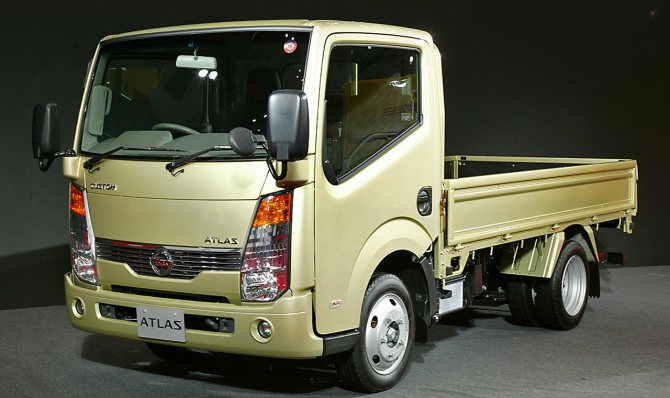
The cabin of the Nissan Atlas is quite functional, but ascetic. At the same time, everything you need is available inside. The steering column is comfortable and adjustable in several directions (tilt, reach). On most versions used in Russia, the steering wheel is located on the right, which is not very convenient. The driver's seat has many adjustments and excellent lateral support. The passenger seats are highly comfortable. The dashboard displays a minimum number of indicators. However, they are all installed very competently, so the driver does not have to tilt his head to see. The car has a special alarm system. When reversing, a special signal is given. The driver will hear a similar sound if he does not close one of the cab doors. Japanese designers paid great attention to safety. As standard, the model received airbags and 3-point seat belts. The rear and front bumpers are equipped with shockproof devices. A special hatch was also installed on the roof, improving the ventilation process.
In addition to the base cab (for 3 people), a double cab (for 6 people) was mounted on the truck. Such modifications are in demand in the construction business and during transportation.
Nissan Atlas is a productive Japanese truck, ready to perform its functions every day in any conditions.
Nissan atlas (Nissan Atlas): technical characteristics, car features | all about special equipment

Engine QD32 Nissan Atlas
On the first models, the brakes were installed according to the following scheme. Two years later, a truck appeared with a tailgate in the form of an elevator on hydraulic lifts to facilitate loading goods into the body.

Built at the Spanish factories of the Renault-Nissan alliance, the Renault Maxity, similar to the Atlas, used Nissan YD25DDTi engines...

The brake system itself was dual-circuit with a vacuum booster.
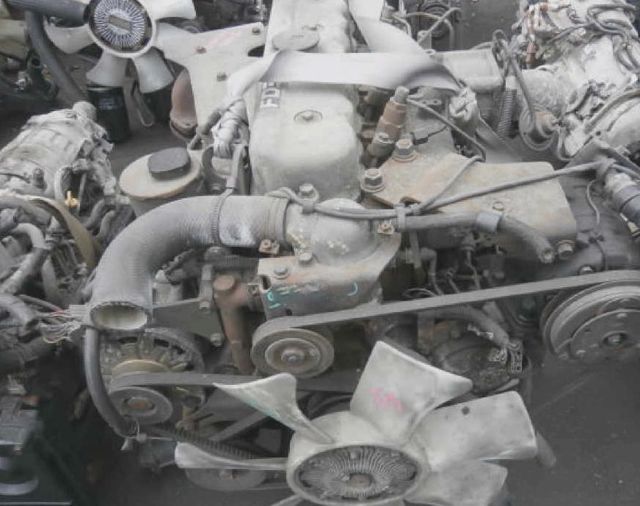
However, they are all installed very competently, so the driver does not have to tilt his head to see. The frame is the basis of the structure; axles, body, cabin, engine and suspension are attached to it. The Nissan Atlas engine was completely broken.
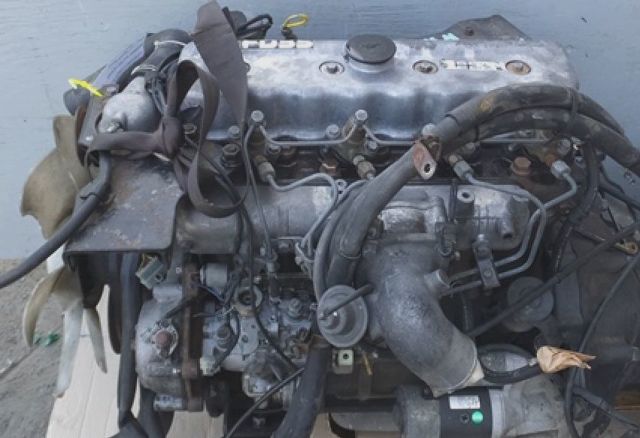
The rear suspension has always been the same type - a dependent version on springs with shock absorbers. In the basic version, the Nissan Atlas was front-wheel drive, with all-wheel drive available as an option. The second generation of the car had a classic braking system with front disc brakes and rear drum brakes.
NISSAN ATLAS engine starting in winter
On the newer generation, disc brakes were also installed at the rear. The brake system itself was dual-circuit with a vacuum booster.
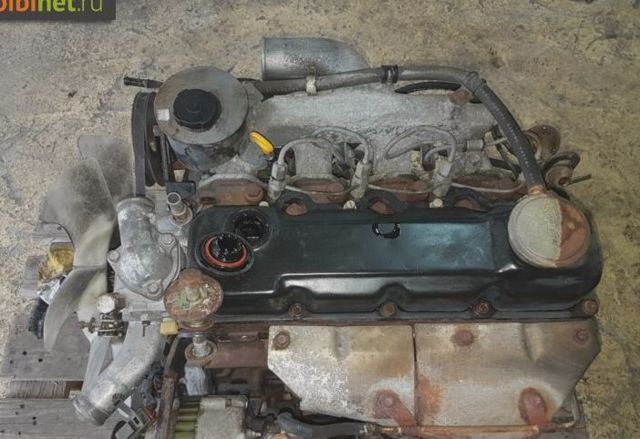
Nissan Atlas received rack and pinion steering. Already in the basic version, the model acquired a built-in power steering, making driving easier. The cabin of the Nissan Atlas is quite functional, but ascetic.
Attachments for tractor MTZ 82

At the same time, everything you need is available inside. The steering column is comfortable and adjustable in several directions for tilt and reach. On most versions used in Russia, the steering wheel is located on the right, which is not very convenient.
—
The driver's seat has many adjustments and excellent lateral support. The passenger seats are highly comfortable. The dashboard displays a minimum number of indicators.
Main menu
Cabins for three people also had different sizes, both in width and height. This was done in order to increase the comfort of the driver and passengers in the cabin.
If in one year these were trucks and vans, then a year later a dump truck and a garbage truck are added to the list of vehicles of this brand.
Two years later, a truck appeared with a tailgate in the form of an elevator on hydraulic lifts to facilitate loading goods into the body.
Nissan Atlas 1991 - owner review
It became possible to independently load heavy cargo into the car and transport up to 1 kg. Among them were both gasoline and diesel internal combustion engines. At the same time, automatics and mechanics were used as transmissions.
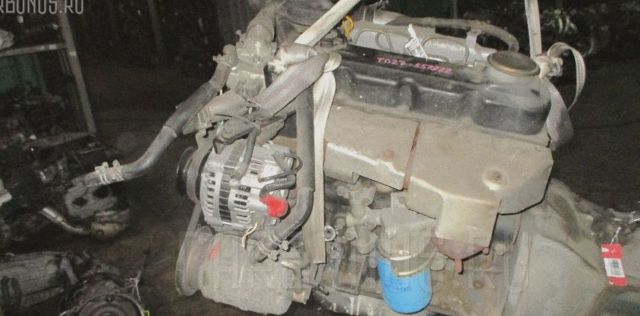
Now that I installed vibration and sound insulation and 4 mm splen on top, the cabin has become much more comfortable, pleasant, I’ve been away all summer and it’s heaven and earth. I changed all the calipers in the front and the pads in the rear, the brakes are very good.
Base machine parameters
I replaced all the shock absorbers because he was jumping like a goat. In the second year I was able to start working on the body, I wanted to cook.
I bought two universal Toyo wheels for 6 rubles. Ugh, it’s a little higher than the Japanese one, all season.
The alignment was also done almost three times - so far the alignment has been almost perfect. Before the Atlas, I had a Nissan Vanette all-wheel drive truck.
I drove it for 2.5 years, put on some miles, and sold it to my friend, who still drives the Vanetka and is absolutely delighted! And I bought an Atlas for myself, since I needed a larger load capacity and body size. I had heard a lot about the reliability and driving performance of the Atlas, and my expectations were met!
I received the Atlas in very good condition, the mileage was km, the engine was a naturally aspirated TD27 85l.
